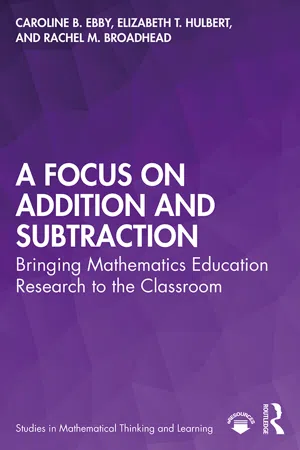
A Focus on Addition and Subtraction
Bringing Mathematics Education Research to the Classroom
- 224 pages
- English
- ePUB (mobile friendly)
- Available on iOS & Android
A Focus on Addition and Subtraction
Bringing Mathematics Education Research to the Classroom
About This Book
This innovative text offers a unique approach to making mathematics education research on addition, subtraction, and number concepts readily accessible and understandable to pre-service and in-service teachers of grades K–3.
Revealing students' thought processes with extensive annotated samples of student work and vignettes characteristic of teachers' experiences, this book provides educators with the knowledge and tools needed to modify their lessons and improve student learning of additive reasoning in the primary grades. Based on research gathered in the Ongoing Assessment Project (OGAP), this engaging, easy-to-use resource features practical resources such as:
-
- A close focus on student work, including 150+ annotated pieces of student work, to help teachers improve their ability to recognize, assess, and monitor their students' errors and misconceptions, as well as their developing conceptual understanding;
-
- A focus on the OGAP Addition, Subtraction, and Base Ten Number Progressions, based on research conducted with hundreds of teachers and thousands of pieces of student work;
-
- In-chapter sections on how Common Core State Standards for Math (CCSSM) are supported by math education research;
-
- End-of-chapter questions to allow teachers to analyze student thinking and consider instructional strategies for their own students;
-
- Instructional links to help teachers relate concepts from each chapter to their own instructional materials and programs;
- An accompanying eResource, available online, offers an answer key to Looking Back questions, as well as a copy of the OGAP Additive Framework and the OGAP Number Line Continuum.
A Focus on Addition and Subtraction marks the fourth installment of the popular A Focus on … collection, designed to aid the professional development of pre-service and in-service mathematics teachers. Following from previous volumes on ratios and proportions, multiplication and division, and fractions, this newest addition is designed to bridge the gap between what math education researchers know and what teachers need to know in order to better understand evidence in student work and make effective instructional decisions.
Frequently asked questions
Information
1
Additive Reasoning and Number Sense
- Additive reasoning includes various mathematical skills, concepts, and abilities that contribute to number sense.
- Additive reasoning is built on concepts of early number, including part–whole relationships, commutativity, and the inverse relationship between addition and subtraction.
- Additive reasoning both depends upon, and contributes to, the development of base-ten number understanding.
- The OGAP Additive Framework contains learning progressions that provide instructional guidance for teachers so that all students can access the important concepts and strategies that lead to additive reasoning.
Additive Reasoning: The Mathematical Foundations
Commutativity

 | Chapter 5 Visual Models to Support Additive Reasoning for more on the importance of visual models and Chapter 6 Developing Whole Number Addition for more on the commutative property. |
The Inverse Relationship between Addition and Subtraction

Connecting Additive Reasoning and Base-Ten Understanding
What Is Number Sense?
Additive Reasoning and Number Sense: From a Teaching and Learning Perspective
Table of contents
- Cover
- Half Title
- Series Page
- Title Page
- Copyright Page
- Dedication
- Table of Contents
- Preface
- Acknowledgments
- 1. Additive Reasoning and Number Sense
- 2. The OGAP Additive Framework
- 3. The Development of Counting and Early Number Concepts
- 4. Unitizing, Number Composition, and Base-Ten Understanding
- 5. Visual Models to Support Additive Reasoning
- 6. Developing Whole Number Addition
- 7. Developing Whole Number Subtraction
- 8. Additive Situations and Problem Solving
- 9. Developing Math Fact Fluency
- References
- About the Authors
- Index